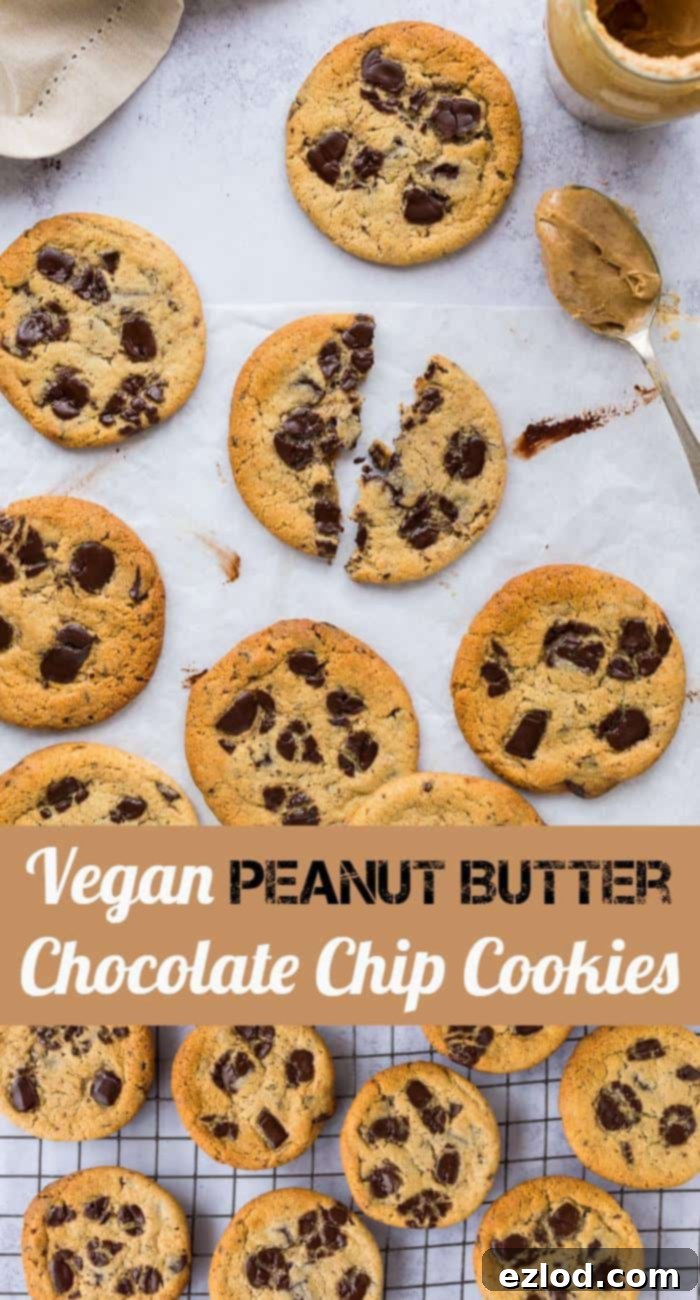The Ultimate Guide to Irresistible Vegan Peanut Butter Chocolate Chip Cookies
Chewy in the middle and crispy around the edges, these plant-based peanut butter chocolate chip cookies are not just easy to make, they’re incredibly moreish and utterly unforgettable!

Vegan peanut butter chocolate chip cookies. Do those words alone not evoke a sense of pure culinary bliss? This classic combination, now made entirely plant-based, is a treat that truly speaks for itself. Prepare to fall in love with a cookie that delivers on every promise of flavor and texture.
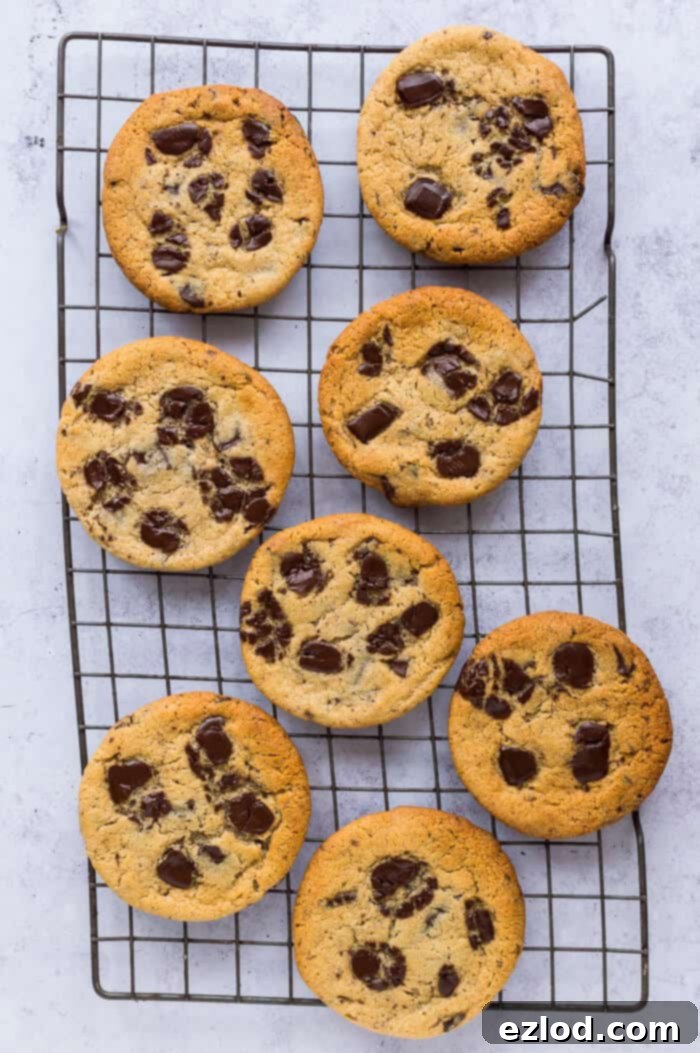
Why These Vegan Peanut Butter Chocolate Chip Cookies Are a Must-Try
This recipe is a loving adaptation of our incredibly popular vegan chocolate chip cookies, re-imagined to embrace the irresistible allure of peanut butter. Because, let’s be honest, is there any combination more heavenly than the harmonious trio of creamy peanut butter, rich chocolate, and a perfectly baked cookie? We’re confident you’ll agree!
What truly elevates these cookies is their absolutely perfect texture. Each bite offers that sought-after balance: a delightfully soft, chewy interior that transitions beautifully into wonderfully crisp, golden-brown edges. This textural interplay is complemented by the robust, nutty flavor of the peanut butter and abundant pockets of rich, melty chocolate throughout. The result is a cookie experience that is truly unforgettable and deeply satisfying for anyone craving a decadent treat.
Beyond their fantastic taste and texture, these **plant-based peanut butter cookies** are also incredibly quick and straightforward to prepare. This is a massive advantage for those moments when a sudden cookie craving strikes, and you need a delicious solution fast! The recipe, as written, yields a cozy batch of eight cookies – perfect for a small household or intimate sharing. However, it’s easily scalable; simply double the ingredients to bake sixteen delicious cookies if you’re feeding a larger crowd or simply wish to stock up on these delightful treats.
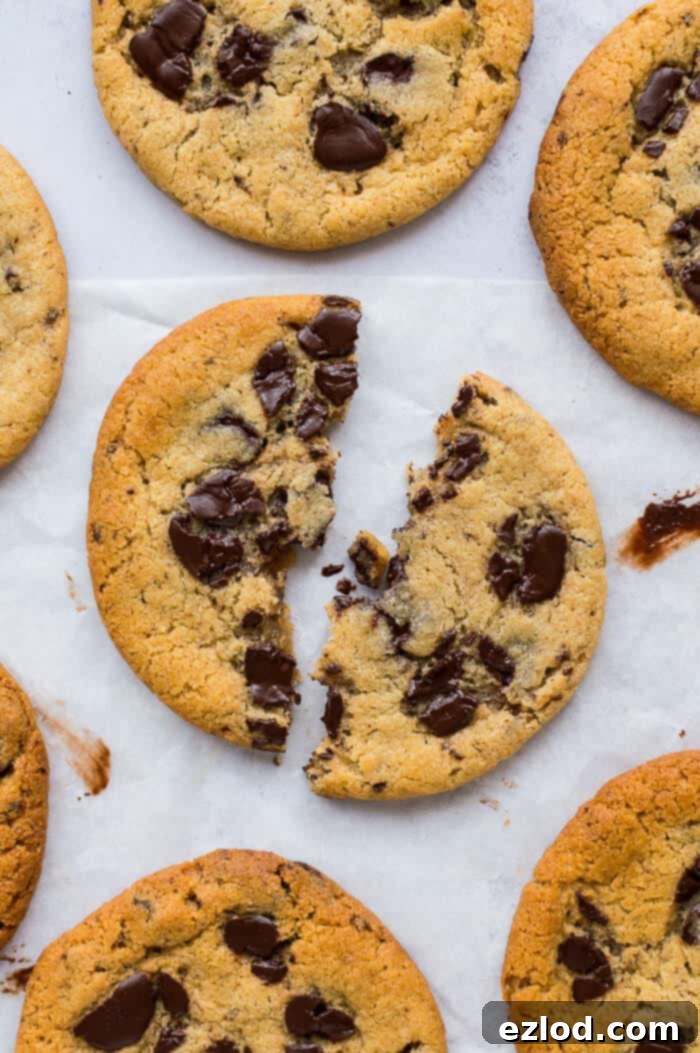
The Joy of Delicious Plant-Based Baking
Vegan baking has truly come into its own, demonstrating unequivocally that you don’t need dairy or eggs to create truly spectacular desserts. These **dairy-free peanut butter chocolate chip cookies** are a shining example of this evolution. By carefully selecting plant-based alternatives and understanding their unique properties, we can achieve textures and flavors that not only rival but often surpass traditional recipes. This particular recipe focuses on simple, accessible ingredients, making vegan baking approachable and enjoyable for everyone, whether you’re a seasoned plant-based chef or just beginning your journey into dairy-free and egg-free cooking.
Crafting Your Perfect Vegan Peanut Butter Chocolate Chip Cookies: A Step-by-Step Guide
(For a detailed list of ingredients and full instructions, please refer to the comprehensive recipe card below. It contains all the precise measurements you’ll need!)
*For optimal results and to ensure your cookies turn out perfectly every time, we strongly recommend adhering closely to the recipe. As always, using gram measurements with a digital scale is highly advised over cup conversions. Cup measurements can be imprecise in baking, and we cannot guarantee the best outcome if they are used.*
Step 1: Creaming the Vegan Butter, Peanut Butter, and Sugars
The foundation of these perfect **vegan peanut butter cookies** is built during the initial creaming process. Much like most classic cookie recipes, we begin by combining softened vegan butter and both types of sugar until the mixture becomes light, fluffy, and noticeably aerated. The exciting and flavor-packed twist here is the immediate addition of creamy peanut butter, which infuses the entire dough with its wonderful nutty essence from the very start. You can achieve this delightful consistency efficiently with an electric mixer, or if you prefer a more traditional and hands-on approach, a sturdy wooden spoon and a bit of “elbow grease” will certainly do the trick!
To achieve that ultimate cookie texture – the highly sought-after balance of being chewy in the middle and crispy at the edges – a carefully chosen blend of both brown and white sugars is absolutely essential. We’ve discovered that a perfect 50/50 ratio works wonders, with the light brown sugar contributing crucial moisture and promoting that irresistible chewiness, while the caster (superfine) white sugar ensures those desirable crisp edges and a delicate crumb.
Step 2: Incorporating Wet Ingredients for Flavor and Moisture
Once your vegan butter, peanut butter, and sugars have been perfectly creamed to a light and airy consistency, it’s time to introduce the liquid components that will bring depth of flavor and necessary moisture to our dough. Whisk in a generous dash of pure vanilla extract; this ingredient is absolutely essential for enhancing the overall flavor profile of these **chocolate chip peanut butter cookies**, adding a warm, aromatic note that complements the other flavors beautifully. To provide the necessary moisture and binding properties typically offered by a chicken egg in traditional recipes, we incorporate a small amount of plant milk. While soy milk is often lauded for its exceptional qualities in vegan baking due to its protein content, any unsweetened non-dairy milk variety you have readily available will work wonderfully.
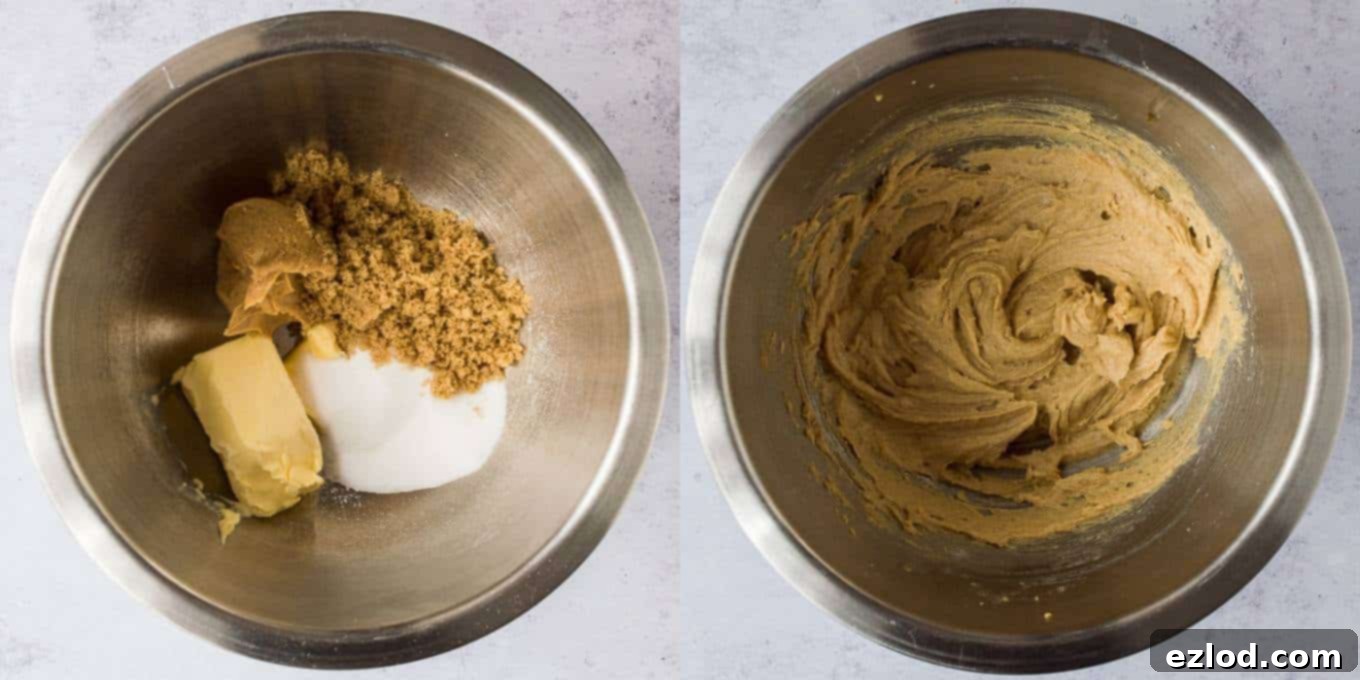
Step 3: Mixing in Dry Ingredients and Chocolate Chunks
Now, it’s time to gently fold in your dry ingredients. This includes plain (all-purpose) flour, baking powder to help with lift and tenderness, a crucial pinch of salt to balance the sweetness and enhance all the flavors, and importantly, cornflour (also known as cornstarch in some regions). The cornflour plays a vital and ingenious role in this vegan recipe, acting as an additional binder and helping to achieve that wonderfully tender yet resiliently chewy texture, effectively replacing and mimicking many of the structural properties traditionally provided by an egg.
Finally, it’s time to introduce the undeniable star of the show: chocolate! Carefully stir through the majority of your chopped dark chocolate, ensuring it’s evenly distributed throughout the rich peanut butter dough. Here’s a pro tip for creating the most aesthetically pleasing and irresistible cookies: make sure to reserve a small, strategic handful of chocolate chunks. These will be thoughtfully pressed onto the tops of your cookie dough balls just before they enter the oven, melting into irresistible, glistening pools of chocolate that look every bit as good as they taste.
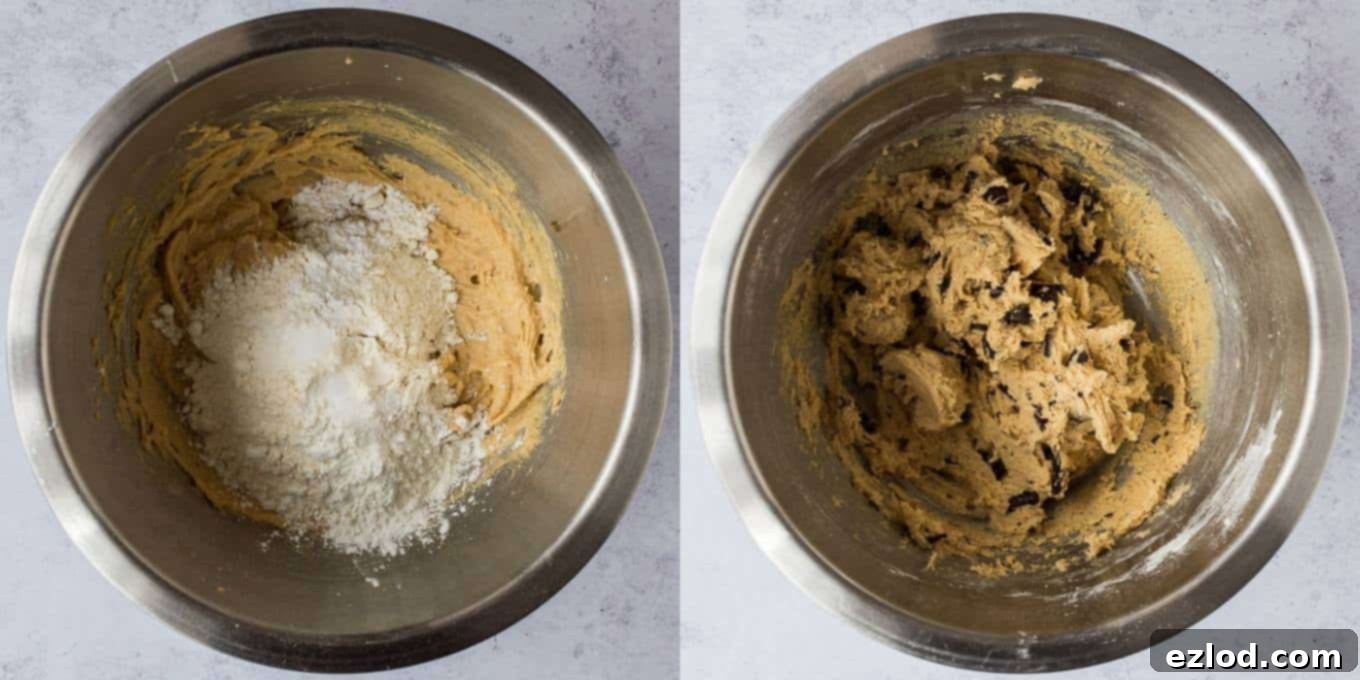
Step 4: Shaping, Essential Chilling, and Pre-Bake Prep
Once your beautifully prepared dough is ready, the next step is to divide it accurately into eight equal portions. Rolling each portion into a neat, uniform ball is important as it ensures even baking and a consistent cookie shape for every single cookie. Place these dough balls well-spaced apart on a couple of baking sheets that have been meticulously lined with baking parchment. This crucial step prevents any sticking and makes for effortless cleanup after baking. Gently flatten each ball very slightly with the palm of your hand – this small action helps them spread into that classic, desirable cookie shape during their time in the oven.
Now, take those thoughtfully reserved chocolate chunks and lovingly press a few pieces onto the very top of each cookie dough ball. This simple yet effective step significantly elevates the visual appeal and ensures a beautiful chocolatey finish. Once completed, pop the trays into the fridge for at least half an hour. This chilling step is not just recommended; it’s highly advised for achieving the absolute best texture. Chilling allows the fats within the dough to firm up, which in turn prevents excessive spreading in the oven and actively promotes that desirable chewy-crispy contrast. While the dough is chilling, take this time to preheat your oven to the specified temperature, ensuring it’s perfectly ready for baking.
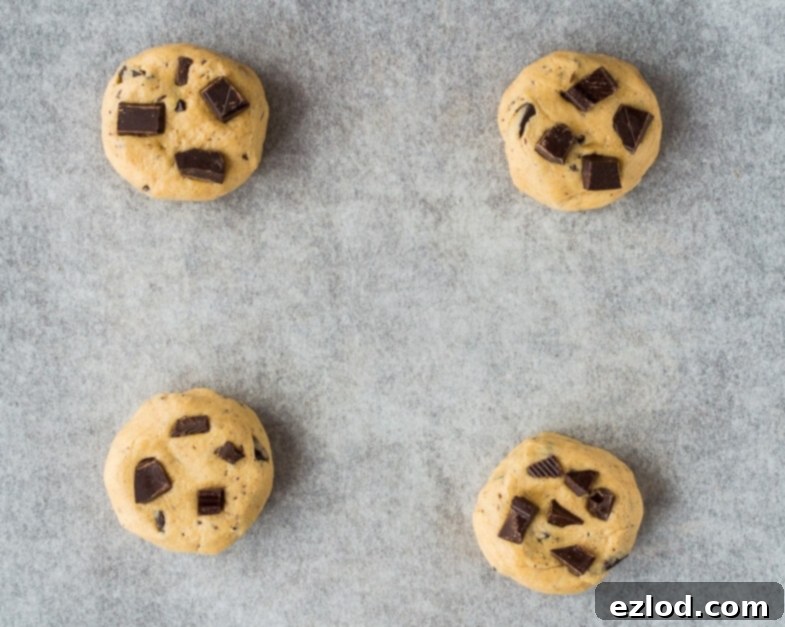
*(While you can bake these **easy vegan peanut butter cookies** immediately if you’re in an absolute rush, the vastly superior texture achieved through the chilling process makes it well worth the brief wait. Another fantastic option is to prepare the dough in advance: when covered tightly to prevent any drying, it can be stored safely in the fridge for several days before baking. Furthermore, the shaped cookie dough balls can be frozen and then baked directly from frozen as needed, extending your cookie enjoyment for weeks and providing ultimate convenience!)*
Step 5: The Perfect Bake and Optional Post-Bake Flattening
Once your cookie dough is perfectly chilled and your oven is preheated to the correct temperature, transfer the trays carefully into the oven. Bake the cookies for approximately fifteen minutes. It’s important to remember that exact baking times can vary slightly depending on the specific calibration of your oven and your personal preference for how “done” you like your cookies. Every oven is a little different, so slight adjustments may be necessary.
For a softer, delightfully chewier cookie, bake until they are just pale golden around their edges, with centers still looking a bit soft. If you prefer a cookie with a bit more crunch and a firmer texture, allow them to bake for an additional minute or two until they achieve a deeper, more pronounced golden hue. Don’t be alarmed if they still seem quite soft and delicate when you initially pull them out of the oven; they will continue to firm up beautifully as they cool on the baking sheet. If you’re unsure about your oven’s particular quirks, a smart approach is to bake a single test cookie first. This will help you perfectly gauge the ideal baking time for your specific setup, ensuring consistent results for the rest of your batch.
Here’s a fun, entirely optional trick for achieving flatter, chewier cookies with crinkled edges: immediately after removing the freshly baked cookies from the oven, lift each tray and gently drop it from a modest height of about 20-30cm (approximately 8-12 inches) onto your counter top. This slight but impactful action helps the cookies settle, release any trapped air, and flatten out, creating those coveted crinkled edges and enhancing their chewy texture. It’s completely optional – if you prefer a thicker, puffier cookie, simply skip this step. Personally, I find the process, and the satisfying “thud,” quite enjoyable and a signature part of my cookie-making routine!
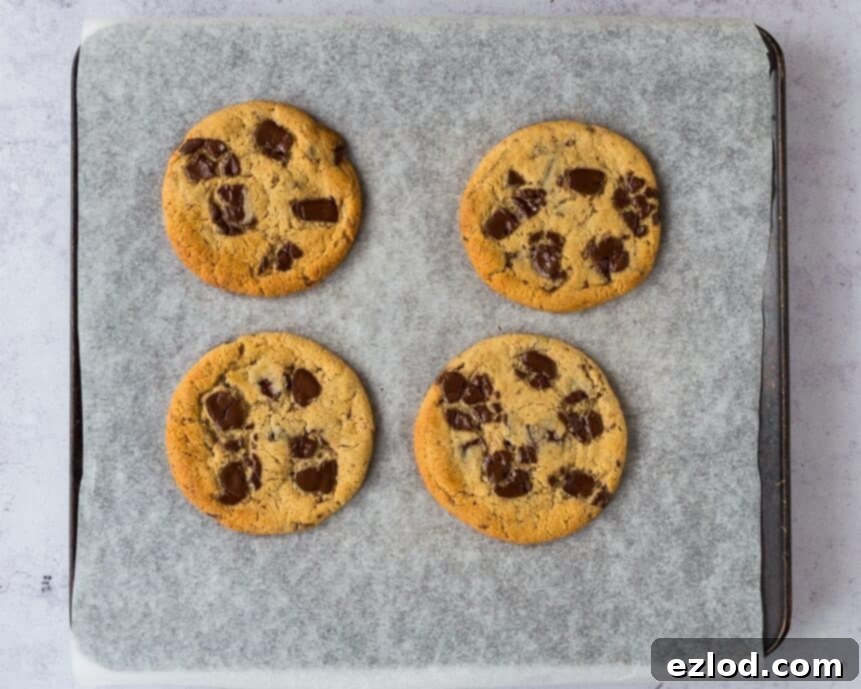
Step 6: Cooling for Perfection and Optimal Storage
After their time in the oven, it’s crucial to allow these **homemade vegan cookies** to cool on the baking tray for approximately ten minutes. They are quite delicate and soft when hot, so this initial cooling period is absolutely vital for them to firm up sufficiently and become much easier to handle without breaking. Once they’ve firmed up slightly and are less fragile, carefully transfer them from the baking tray to a wire rack to cool completely. This allows air to circulate around them, preventing sogginess and ensuring that perfect chewy-crispy texture.
These delicious cookies are, without a doubt, at their absolute peak when enjoyed fresh – ideally still slightly warm with the chocolate just barely melty. However, any leftover cookies will keep beautifully and retain their wonderful flavor and texture in an airtight container at room temperature for a couple of days. For longer storage, consider the freezing options discussed below.
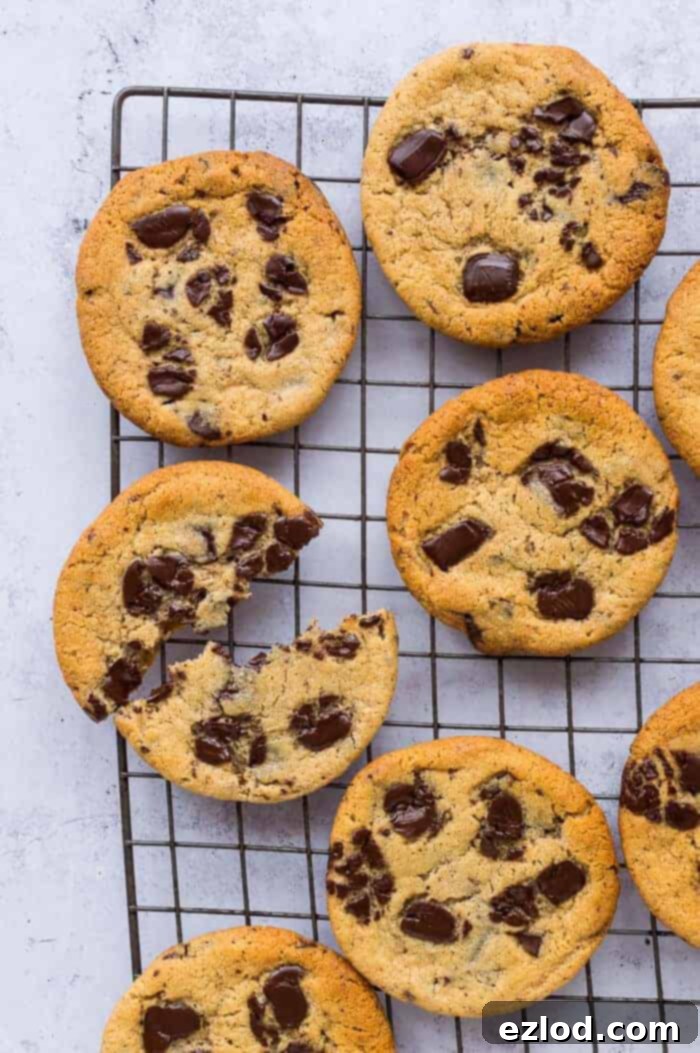
The Best Ingredients For Your Vegan Peanut Butter Chocolate Chip Cookies
Selecting the right ingredients is paramount to the success of any baking project, especially when working with plant-based alternatives. Here’s what you need to know to ensure your **vegan peanut butter chocolate chip cookies** turn out perfectly every single time:
Vegan Butter/Margarine: Choose Wisely for Baking Success
This ingredient is absolutely critical for the structure and texture of your cookies. You must ensure that you use a solid block-style vegan butter or margarine. These products are specifically formulated for baking applications and possess a fat-to-water ratio that closely mimics traditional dairy butter, which is essential for proper cookie spread and texture. **It is imperative that you do NOT use the spreadable kind that comes in a tub**, as these varieties typically contain a significantly higher water content. Using spreadable margarine will inevitably result in cookies that spread excessively in the oven, leading to a thin, greasy, and ultimately inferior texture – a definite baking mishap you want to avoid!
In the UK, excellent and reliable options for block vegan butter include Naturli Vegan Block or Stork block margarine (always double-check that it is indeed the block format, not the tub). Violife also offers a block margarine, though it’s worth noting that I haven’t personally tested it for this specific cookie recipe. For those in the US, Earth Balance buttery sticks are generally considered the most suitable and widely available product for successful vegan baking. Always take a moment to check the ingredient list and product description to confirm it’s a solid, baking-appropriate block.
Peanut Butter: Creamy Texture is Key for Consistency
For this recipe, I consistently rely on and recommend Whole Earth smooth peanut butter, which boasts a wonderfully creamy and consistent texture that blends beautifully into the dough. Any high-quality creamy peanut butter should yield excellent results. I haven’t specifically tested these **plant-based chocolate chip cookies** with crunchy peanut butter, but if you do opt for it, you might consider slightly increasing the amount to ensure the desired texture and a robust peanut flavor intensity, as the added nut pieces can sometimes absorb more moisture.
I also haven’t extensively experimented with natural peanut butter (the kind where the oil naturally separates and requires thorough stirring before use). While it *might* work, natural peanut butter tends to be runnier due to its minimal processing, which could potentially cause the cookies to spread more during baking. If you decide to use it, be prepared for a potentially slightly different outcome, possibly requiring a bit more flour to compensate for the extra oil or a longer, more rigorous chilling time for the dough.
Chocolate: Chopped vs. Chips for Ultimate Flavor
While chocolate chips offer undeniable convenience, I have a strong personal preference for using chopped dark chocolate in my cookies. When you take a good quality bar of dark chocolate (always ensure it’s vegan-friendly!) and chop it, it creates irregular shards and varying sizes of chocolate pieces. This not only results in a more appealing, rustic, and artisanal look but also ensures a far more even distribution of rich chocolate flavor throughout each cookie. You get delightful, unexpected pockets of intensely melted goodness in every bite. However, if you prefer the classic uniform look and the ease of pre-made chocolate chips, they will certainly work well in this recipe. Just be absolutely sure to use **vegan chocolate chips** to keep the recipe plant-based!
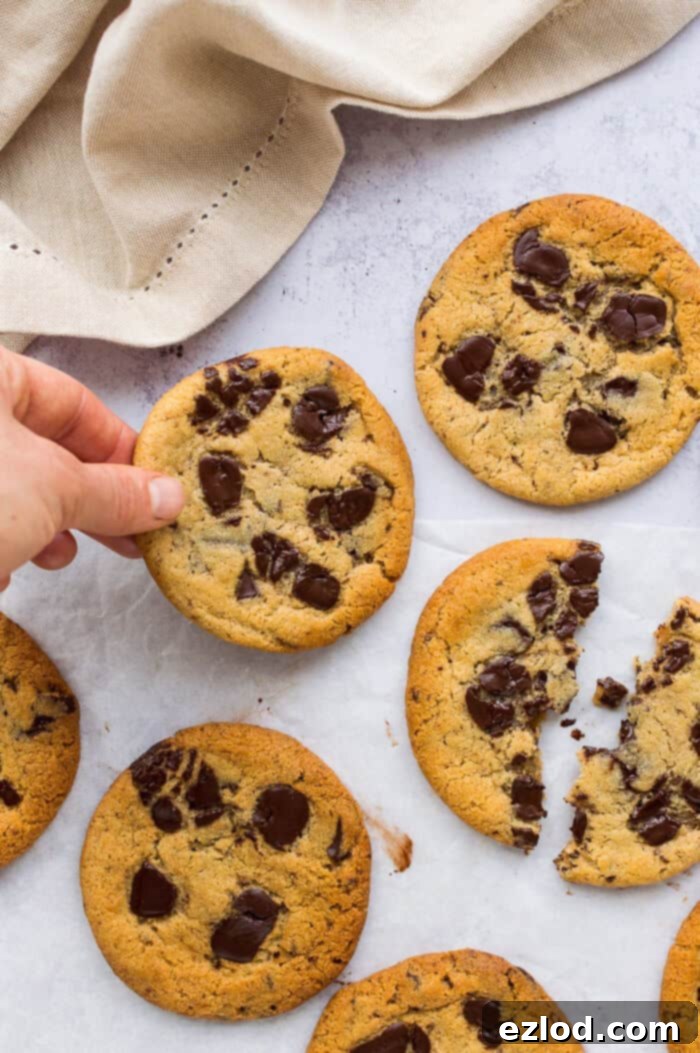
Can I Freeze These Vegan Peanut Butter Chocolate Chip Cookies? Absolutely!
Yes, absolutely! These **easy vegan peanut butter chocolate chip cookies** are wonderfully adaptable for making ahead and freezing, whether you prefer to freeze the unbaked dough or even the fully baked cookies. This makes them incredibly convenient for satisfying spontaneous cookie cravings, simplifying your dessert meal prep, or ensuring you always have a delicious treat on hand for unexpected guests.
Freezing Unbaked Cookie Dough:
Once you have expertly prepared the cookie dough and meticulously shaped it into individual balls following the recipe instructions, arrange them spaced apart on a tray or plate that can comfortably fit into your freezer. Freeze them solid for a few hours. Once they are rock-solid, transfer the frozen cookie dough balls to a freezer-safe ziplock bag or an airtight container. Make sure to label them clearly with the date for future reference. They can be stored in the freezer for up to 2-3 months without losing quality. When you’re ready to bake, you can simply pop them straight from the freezer into a preheated oven, though they may require an additional minute or two of baking time compared to chilled dough. This method is truly fantastic for enjoying freshly baked **homemade vegan cookies** on demand whenever the craving strikes!
Freezing Baked Cookies:
You can also successfully freeze fully baked cookies. First, allow them to cool completely to room temperature. Then, arrange them in a single layer on a baking sheet and freeze until they are solid. Once frozen, transfer them to a freezer-safe bag or container, separating layers with parchment paper if you need to stack them to prevent sticking. They can be frozen for up to 1-2 months. To enjoy, simply thaw them at room temperature for a couple of hours or gently warm them in a preheated oven for a few minutes to restore that fresh-from-the-oven warmth and chewiness.
More Delicious Vegan Cookie Recipes to Explore
If you’ve thoroughly enjoyed baking and devouring these **easy vegan peanut butter chocolate chip cookies**, you might find immense pleasure in exploring more of our delightful plant-based cookie creations:
- Classic Vegan Chocolate Chip Cookies: A timeless favorite, perfectly plant-based.
- Hearty Vegan Oatmeal Raisin Cookies: Chewy, spiced, and comforting.
- Indulgent Chocolate Raspberry Skillet Cookie for Two: A decadent dessert perfect for sharing.
- Seasonal Vegan Pumpkin Chocolate Chip Cookies: A festive twist with warm spices and chocolate.
Expert Tips for Achieving Perfect Vegan Peanut Butter Chocolate Chip Cookies Every Time
- Don’t Overmix the Dough: Once you’ve added the flour and dry ingredients, mix only until they are just combined and no streaks of dry flour remain. Overmixing can overdevelop the gluten in the flour, which will result in tough, dense cookies rather than light and chewy ones.
- Prioritize Proper Chilling: While it might be tempting to skip this step if you’re in a hurry, chilling the dough is highly, highly recommended. It’s not just about preventing excessive spreading; chilling allows the fats to firm up, the flavors to meld, and ultimately contributes significantly to that perfect chewy-crispy texture and enhanced flavor.
- Invest in Quality Ingredients: The final taste of your cookies is only as good as the ingredients you use. This is especially true for the peanut butter and chocolate. Opt for good quality, flavorful brands of both, as they will elevate the flavor profile of your cookies significantly.
- Ensure Oven Temperature Accuracy: Ovens can be notoriously temperamental and often vary from their set temperature. Using an inexpensive oven thermometer can help ensure your oven is consistently at the correct temperature, which is crucial for preventing burnt bottoms or underbaked centers.
- Choose the Right Baking Sheets: Believe it or not, the color of your baking sheets can impact your cookies. Light-colored baking sheets typically result in more evenly baked cookies with golden bottoms. Darker sheets can sometimes absorb more heat and lead to over-browning on the bottom of the cookies.
- Room Temperature is Key for Fats: Always ensure your vegan butter/margarine and peanut butter are at proper room temperature (softened but not melted) before you begin the creaming process. This allows them to cream smoothly with the sugars, creating an airy base for your dough.
Frequently Asked Questions (FAQ) About Vegan Peanut Butter Chocolate Chip Cookies
Q: Can I use almond butter or another nut butter instead of peanut butter?
A: While you can certainly substitute almond butter or another nut butter for peanut butter, it’s important to be aware that the flavor profile will change quite significantly. Almond butter cookies, for instance, will typically have a milder, less robust nutty flavor compared to the distinct taste of peanut butter. The texture might also vary slightly; some nut butters can be thinner or oilier than standard creamy peanut butter, which could potentially lead to the cookies spreading more during baking. If you do make a substitution, you might consider slightly increasing the flour by a tablespoon or two, or ensuring a longer chilling time for the dough, to help maintain the desired structure.
Q: Are these cookies gluten-free?
A: As written, this specific recipe is not gluten-free as it utilizes plain (all-purpose) wheat flour. However, you can likely adapt it to be gluten-free by substituting a good quality 1:1 gluten-free all-purpose flour blend that is formulated to contain xanthan gum. Ensure your chosen blend is specifically recommended for baking cookies. Please note that results may vary slightly in terms of texture and chewiness, as gluten-free flours can behave differently from wheat flour.
Q: Why did my cookies spread too much in the oven?
A: Excessive spreading is a common issue in cookie baking and can be attributed to a few key factors. Your vegan butter might have been too soft or had too high a water content (this is a very common culprit if you used a spreadable tub margarine instead of a solid block butter). Another reason could be that the dough wasn’t chilled for long enough (or at all) before baking. Your oven temperature might also have been too low, or you might have used a natural, particularly oily peanut butter without adjusting the other ingredients. To prevent this, ensure you meticulously follow the ingredient recommendations, particularly regarding the type of vegan butter, and strictly adhere to the chilling step for the best results.
Q: How can I make these cookies even more indulgent or add variations?
A: For an extra touch of indulgence, consider adding a sprinkle of flaky sea salt on top of the cookies just before baking. This simple addition beautifully enhances and balances both the chocolate and peanut butter flavors. You could also mix in a small handful of chopped pecans or walnuts into the dough for added texture and a different nutty note. For a fun, s’mores-like twist, try stirring in a few vegan mini marshmallows during the last few minutes of baking, or pressing them onto the tops of the cookies with the chocolate chunks.
Conclusion: Your New Favorite Vegan Treat Awaits!
These **vegan peanut butter chocolate chip cookies** are truly more than just a dessert; they represent a delightful celebration of flavor, texture, and the endless, delicious possibilities of plant-based baking. With their perfect balance of a delightfully chewy interior and wonderfully crispy edges, the rich, harmonious blend of creamy peanut butter and decadent chocolate, and a straightforward, accessible baking process, they are absolutely guaranteed to become a cherished staple in your recipe collection. Whether you’re baking a batch for yourself, sharing with cherished friends, or impressing family members, prepare to delight and impress everyone with these utterly irresistible, completely dairy-free, and remarkably satisfying treats. Happy baking, and enjoy every single bite!
If you tried this recipe, we’d absolutely love to see your delicious creations! Why not tag @domestic_gothess on Instagram and use the hashtag #domesticgothess to share your culinary results?
*All images and content on Domestic Gothess are copyright protected. If you wish to share this recipe, please do so by utilizing the provided share buttons. Please do not screenshot, copy, or reproduce the recipe or content in full.*

Print
Vegan Peanut Butter Chocolate Chip Cookies
Ingredients
- 60 g (¼ cup) vegan block butter/margarine (NOT the spreadable kind) softened to room temperature
- 60 g (¼ cup) creamy peanut butter at room temperature
- 50 g (¼ cup) caster (superfine) sugar
- 50 g (packed ¼ cup) light brown soft sugar
- 1 Tbsp unsweetened non-dairy milk (I recommend soy for baking)
- 1 tsp vanilla extract
- 80 g (⅔ cup) plain (all-purpose) flour
- 10 g (1 Tbsp) cornflour (cornstarch)
- ½ tsp baking powder
- ¼ tsp salt
- 85 g (3 oz) dark chocolate finely chopped (ensure it’s vegan)
Instructions
-
In a large mixing bowl, combine the softened vegan block butter, creamy peanut butter, caster sugar, and light brown soft sugar. Whisk with an electric mixer until the mixture is light, pale, and fluffy. (Alternatively, a sturdy wooden spoon and some elbow grease will work too!).
-
Add the unsweetened non-dairy milk and vanilla extract to the creamed mixture. Whisk again until all the wet ingredients are thoroughly combined and smooth.
-
In a separate bowl, briefly whisk together the plain flour, cornflour, baking powder, and salt. Add these dry ingredients to the wet mixture and mix on a low speed or fold gently with a spoon until just combined and a soft dough forms. Be careful not to overmix.
-
Stir in most of the chopped dark chocolate into the cookie dough, ensuring it’s evenly distributed. Remember to reserve a small handful of chocolate chunks to press onto the tops of the cookies later.
-
Line a couple of baking sheets with baking parchment. Divide the cookie dough into eight equal portions and roll each portion into a smooth ball. Place the dough balls well-spaced apart on the prepared baking trays. Gently flatten each one very slightly with the palm of your hand.
-
Press a few chunks of the reserved chocolate onto the top of each cookie dough ball for an appealing finish. Place the trays in the fridge for at least 30 minutes to chill the dough. (Chilling is highly recommended for the best texture, but cookies can be baked right away if necessary. The dough can also be covered and stored in the fridge for several days, or the shaped cookie dough balls can be frozen and baked from frozen).
-
While the dough chills, preheat your oven to 180C/350F/gas mark 4. Once chilled, bake the cookies for about 15 minutes, or until the edges are golden brown. The centers will still appear soft but will firm up as they cool. Adjust baking time slightly for softer (less golden) or crispier (more golden) cookies.
-
Immediately after removing the baked cookies from the oven, lift each tray and gently drop it from a height of about 20-30cm (8-12 inches) onto the counter top. This optional step helps to flatten the cookies out slightly and create crinkled edges; skip if you prefer a thicker cookie.
-
Leave the cookies to cool on the baking tray for ten minutes, as they are very delicate when hot. Once they have cooled and firmed up a bit, carefully transfer them to a wire rack to cool completely. Store any leftover cookies in an airtight container at room temperature for a couple of days.
Notes
